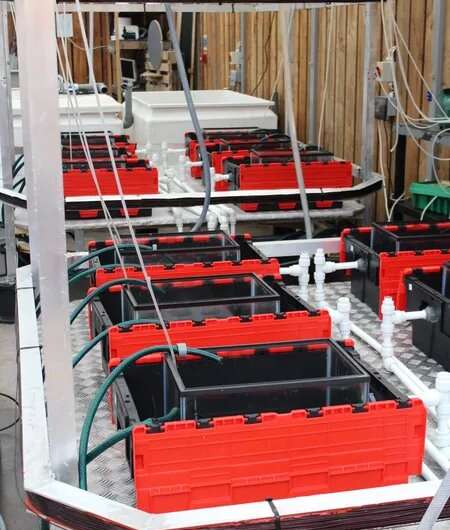Credit: St. Abbs Marine Station
Brown crabs can't resist the electromagnetic pull of underwater power cables and it's changing their behavior, marine scientists say.
The team behind a new study says the power cables linked to offshore renewable energy devices affect how crabs interact with the environment.
The change affects their biology at a cellular level.
Brown crabs are the UK's second most valuable crustacean catch and the most valuable inshore catch. So changes in their behavior could have real economic consequences.
Dr. Alastair Lyndon, from Heriot-Watt University, said: "Underwater cables emit an electromagnetic field. When it's at a strength of 500 microTeslas and above, which is about five percent of the strength of a fridge door magnet, the crabs seem to be attracted to it and just sit still.
"That's not a problem in itself. But if they're not moving they're not foraging for food or seeking a mate.
"The change in activity levels also leads to changes in sugar metabolism—they store more sugar and produce less lactate, just like humans."
The scientists observed around 60 crabs at the St Abbs Marine Station in the Scottish Borders. They used the marine station's purpose-built aquarium laboratory for the experiment.
Dr. Kevin Scott at St Abbs Marine Station said: "The aquarium lab is composed entirely of non-metallic materials, which means there is minimal electromagnetic interference.
"We found that exposure to higher levels of electromagnetic field strength changed the number of blood cells in the crabs' bodies. This could have a range of consequences, like making them more susceptible to bacterial infection."
A number of offshore wind farms are installed and planned around Scotland's coast, and they will come with miles of associated underwater cables.
The research team says not paying attention to or addressing the change in crabs' behavior could have long-term consequences.
Dr. Lyndon said: "Male brown crabs migrate up the east coast of Scotland. If miles of underwater cabling prove too difficult to resist, they'll stay put.
"This could mean we have a build-up of male crabs in the south of Scotland, and a paucity of them in the northeast and islands, where they are incredibly important for fishermen's livelihoods and local economies.
"One potential solution could be to bury the cables in the seafloor. However, that can be expensive, it makes maintenance more difficult and also it's just not possible in some locations.
"We need to investigate further technical solutions so that we don't create negative environmental effects while trying to decarbonise our energy supply."
More information: Kevin Scott et al, Exposure to Electromagnetic Fields (EMF) from Submarine Power Cables Can Trigger Strength-Dependent Behavioural and Physiological Responses in Edible Crab, Cancer pagurus (L.), Journal of Marine Science and Engineering (2021). DOI: 10.3390/jmse9070776
Provided by Heriot-Watt University
























